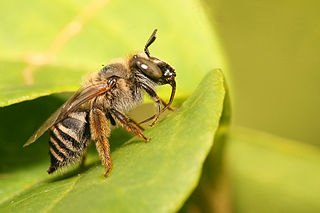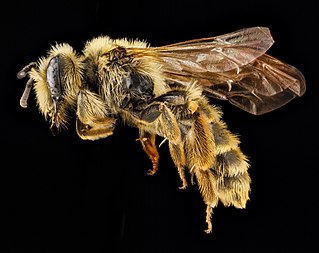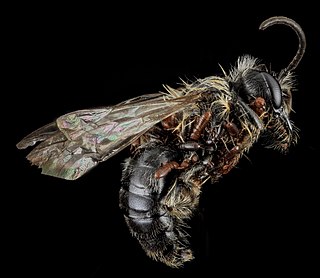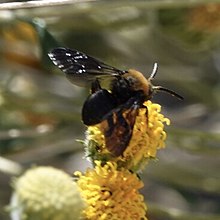
Bees are winged insects closely related to wasps and ants, known for their role in pollination and, in the case of the best-known bee species, the western honey bee, for producing honey. Bees are a monophyletic lineage within the superfamily Apoidea. They are presently considered a clade, called Anthophila. There are over 16,000 known species of bees in seven recognized biological families. Some species – including honey bees, bumblebees, and stingless bees – live socially in colonies while most species (>90%) – including mason bees, carpenter bees, leafcutter bees, and sweat bees – are solitary.

Hover flies, also called flower flies or syrphid flies, make up the insect family Syrphidae. As their common name suggests, they are often seen hovering or nectaring at flowers; the adults of many species feed mainly on nectar and pollen, while the larvae (maggots) eat a wide range of foods. In some species, the larvae are saprotrophs, eating decaying plant and animal matter in the soil or in ponds and streams. In other species, the larvae are insectivores and prey on aphids, thrips, and other plant-sucking insects.

Halictidae is the second-largest family of bees with nearly 4,500 species. Halictid species are an extremely diverse group that can vary greatly in appearance. These bees occur all over the world and are found on every continent except Antarctica. Usually dark-colored and often metallic, halictids are found in various sizes, colors and patterns. Several species are all or partly green and a few are red, purple, or blue. A number of them have yellow markings, especially the males, which commonly have yellow faces, a pattern widespread among the various families of bees. The family is one of many with short tongues and is best distinguished by the arcuate basal vein found on the wing. Females in this family tend to be larger than the males.

Mason bee is a name now commonly used for species of bees in the genus Osmia, of the family Megachilidae. Mason bees are named for their habit of using mud or other "masonry" products in constructing their nests, which are made in naturally occurring gaps such as between cracks in stones or other small dark cavities. When available, some species preferentially use hollow stems or holes in wood made by wood-boring insects.

Andrena is a genus of bees in the family Andrenidae. With over 1,500 species, it is one of the largest genera of animals. It is a strongly monophyletic group that is difficult to split into more manageable divisions; currently, Andrena is organized into 104 subgenera. It is nearly worldwide in distribution, with the notable exceptions of Oceania and South America. Bees in this genus are commonly known as mining bees due to their ground-nesting lifestyle.

The Melectini are a tribe of medium- to large-sized apid bees found essentially worldwide. They are brood parasites of the related typical digger bees (Anthophorini) and occasionally visit flowers e.g. in prairie landscapes of the United States.
Hesperapis is a genus of evening bees in the family Melittidae. There are at least 30 described species in Hesperapis.
Brachymelecta interrupta is a species of digger-cuckoo bee in the family Apidae, found in Central America and North America.

Brachymelecta is a genus of digger-cuckoo bees in the family Apidae, formerly known by the name Xeromelecta.

Hoplitis is a genus of bees in the family Megachilidae. There are more than 380 described species in Hoplitis.

Tetraloniella is a genus of long-horned bees in the family Apidae. There are more than 100 described species in Tetraloniella with most being from North America
Perdita larreae is a species of bee in the family Andrenidae. It is found in Central America and North America.
Trachusa larreae is a species of hymenopteran in the family Megachilidae. It is found in Central America and North America.

The death camas miner bee, is a species of miner bee in the family Andrenidae. Another common name for this species is death camas andrena. It is found in North America. It specialises in feeding on the highly poisonous Toxicoscordion venenosum and is possibly the only bee that can tolerate its toxins.

Ancylandrena is a genus of mining bees in the family Andrenidae. There are about five described species in Ancylandrena.
Ancylandrena larreae, the creosote bush ancylandrena, is a species of mining bee in the family Andrenidae. It is found in Central America and North America.

The Carlinville miner bee is a species of miner bee in the family Andrenidae. Another common name for this species is Carlin's miner. It is found in North America.

Augochloropsis is a genus of brilliant metallic, often blue-green, sweat bees in the family Halictidae. There are at least 140 described species in Augochloropsis.
Hesperapis oraria, known generally as the gulf coast evening bee or gulf coast solitary bee, is a rare species of bee in the family Melittidae. It was first described in 1997. The bee's current known range is on the barrier islands and coastal mainland secondary dunes on the Gulf Coast of the United States in Florida, Alabama, and Mississippi. The Gulf Coast solitary bee is the only known member of its subfamily in the eastern United States, and it is a monolege of the coastal plain honeycomb head.
Hesperapis larreae is a solitary, ground-nesting bee in the family Melittidae













